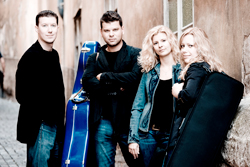by Daniel Hathaway

Founded in 2002 in Prague, the Haas Quartet retains two of its founding members, first violinist Veronika Jarůšková and violist Pavel Nikl. In an amusing swap soon afterward, the Haas Quartet traded cellists with the Škampa Quartet, thus musically reuniting Jarůšková with her husband, Peter Jarůšek. Second violinist Marek Zwiebel joined the ensemble in 2012, becoming the fourth person to occupy that position.
Changes in personnel are worth mentioning if only to marvel at the unanimity of approach such a quartet as the Pavel Haas can maintain as players come and go. Among the ensemble’s distinguishing characteristics is a visceral intensity that can be hair-raising in aggressive music but sustains itself even in quieter passages, along with finely managed dynamics and smooth, even crescendos and diminuendos.
Janáček’s first quartet is a program annotator’s dream: not only does it allude to a literary work — Tolstoy’s novella Kreutzer Sonata — but it also refers obliquely to a famous Beethoven piece. Those links, plus the composer’s confidential and thoroughly unedifying remark to a friend, “I had in mind a wretched, vexed woman who is beaten to death,” promise a rich tapestry of emotions.
In fact, Alfred Hitchcock, the master of suspense, might have found use for Janáček’s music in a film, as mercurial and eventful as the terse, 13-minute score turns out to be. After beginning with a sentimental gesture that will hauntingly return again and again, each player has what can only be described as a psychotic episode — violent jabbings that subside only to become contagious. The players kept all the quartet’s surprises intact so the listener never anticipated the next abrupt change of mood.
Britten’s second quartet is obsessive — both with its idée fixe, the key of C Major, and with the motives the composer derives from that tonality and drills incessantly into the ear. Playing incisively and with slavish adherence to the composer’s intentions, the Haas Quartet put the piece across brilliantly. The closing chacony, a tribute to Henry Purcell, was especially moving as each player contributed a dramatic interludial cadenza before the theme resumed its inexorable progress.
In slightly less than an hour, the Pavel Hass Quartet had made an indelible impression. The evening could have ended quite satisfyingly after the Britten, but there was Beethoven still to come. In the second of the trio of Rasumovsky quartets, op. 59, no. 2, some of the aggressive playing that made Janáček and Britten so gripping seemed misplaced. But Beethoven ultimately served as an effective denouement to what had gone before, and its presto conclusion was thrilling in its own right. The quartet responded to their warm reception from the good-sized audience with a sweet Dvořák waltz.
Published on ClevelandClassical.com April 15, 2014.
Click here for a printable copy of this article.
e



